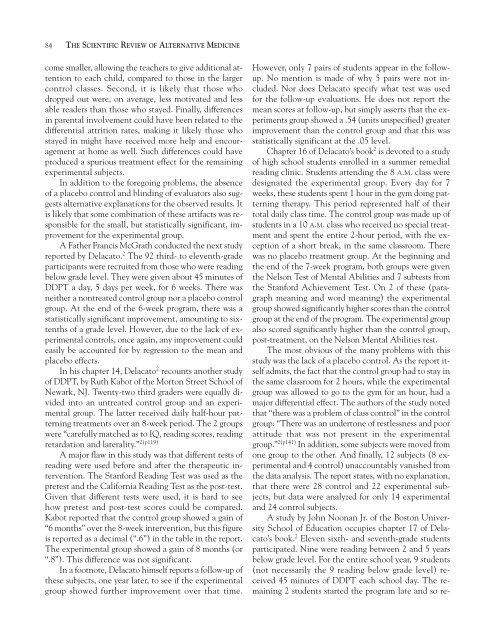THE DOMAN-DELACATO PATTERNING TREATMENT FOR BRAIN ...
THE DOMAN-DELACATO PATTERNING TREATMENT FOR BRAIN ...
THE DOMAN-DELACATO PATTERNING TREATMENT FOR BRAIN ...
Create successful ePaper yourself
Turn your PDF publications into a flip-book with our unique Google optimized e-Paper software.
84 <strong>THE</strong> SCIENTIFIC REVIEW OF ALTERNATIVE MEDICINEcome smaller, allowing the teachers to give additional attentionto each child, compared to those in the largercontrol classes. Second, it is likely that those whodropped out were, on average, less motivated and lessable readers than those who stayed. Finally, differencesin parental involvement could have been related to thedifferential attrition rates, making it likely those whostayed in might have received more help and encouragementat home as well. Such differences could haveproduced a spurious treatment effect for the remainingexperimental subjects.In addition to the foregoing problems, the absenceof a placebo control and blinding of evaluators also suggestsalternative explanations for the observed results. Itis likely that some combination of these artifacts was responsiblefor the small, but statistically significant, improvementfor the experimental group.A Father Francis McGrath conducted the next studyreported by Delacato. 2 The 92 third- to eleventh-gradeparticipants were recruited from those who were readingbelow grade level. They were given about 45 minutes ofDDPT a day, 5 days per week, for 6 weeks. There wasneither a nontreated control group nor a placebo controlgroup. At the end of the 6-week program, there was astatistically significant improvement, amounting to sixtenthsof a grade level. However, due to the lack of experimentalcontrols, once again, any improvement couldeasily be accounted for by regression to the mean andplacebo effects.In his chapter 14, Delacato 2 recounts another studyof DDPT, by Ruth Kabot of the Morton Street School ofNewark, NJ. Twenty-two third graders were equally dividedinto an untreated control group and an experimentalgroup. The latter received daily half-hour patterningtreatments over an 8-week period. The 2 groupswere “carefully matched as to IQ, reading scores, readingretardation and laterality.” 2(p119)A major flaw in this study was that different tests ofreading were used before and after the therapeutic intervention.The Stanford Reading Test was used as thepretest and the California Reading Test as the post-test.Given that different tests were used, it is hard to seehow pretest and post-test scores could be compared.Kabot reported that the control group showed a gain of“6 months” over the 8-week intervention, but this figureis reported as a decimal (“.6”) in the table in the report.The experimental group showed a gain of 8 months (or“.8”). This difference was not significant.In a footnote, Delacato himself reports a follow-up ofthese subjects, one year later, to see if the experimentalgroup showed further improvement over that time.However, only 7 pairs of students appear in the followup.No mention is made of why 5 pairs were not included.Nor does Delacato specify what test was usedfor the follow-up evaluations. He does not report themean scores at follow-up, but simply asserts that the experimentsgroup showed a .54 (units unspecified) greaterimprovement than the control group and that this wasstatistically significant at the .05 level.Chapter 16 of Delacato’s book 2 is devoted to a studyof high school students enrolled in a summer remedialreading clinic. Students attending the 8 A.M. class weredesignated the experimental group. Every day for 7weeks, these students spent 1 hour in the gym doing patterningtherapy. This period represented half of theirtotal daily class time. The control group was made up ofstudents in a 10 A.M. class who received no special treatmentand spent the entire 2-hour period, with the exceptionof a short break, in the same classroom. Therewas no placebo treatment group. At the beginning andthe end of the 7-week program, both groups were giventhe Nelson Test of Mental Abilities and 7 subtests fromthe Stanford Achievement Test. On 2 of these (paragraphmeaning and word meaning) the experimentalgroup showed significantly higher scores than the controlgroup at the end of the program. The experimental groupalso scored significantly higher than the control group,post-treatment, on the Nelson Mental Abilities test.The most obvious of the many problems with thisstudy was the lack of a placebo control. As the report itselfadmits, the fact that the control group had to stay inthe same classroom for 2 hours, while the experimentalgroup was allowed to go to the gym for an hour, had amajor differential effect. The authors of the study notedthat “there was a problem of class control” in the controlgroup: “There was an undertone of restlessness and poorattitude that was not present in the experimentalgroup.” 2(p141) In addition, some subjects were moved fromone group to the other. And finally, 12 subjects (8 experimentaland 4 control) unaccountably vanished fromthe data analysis. The report states, with no explanation,that there were 28 control and 22 experimental subjects,but data were analyzed for only 14 experimentaland 24 control subjects.A study by John Noonan Jr. of the Boston UniversitySchool of Education occupies chapter 17 of Delacato’sbook. 2 Eleven sixth- and seventh-grade studentsparticipated. Nine were reading between 2 and 5 yearsbelow grade level. For the entire school year, 9 students(not necessarily the 9 reading below grade level) received45 minutes of DDPT each school day. The remaining2 students started the program late and so re-



